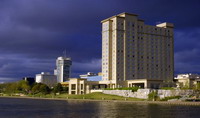Login form
Kansas

“Toto, I have a feeling we’re not in Kansas anymore,” Dorothy says to her dog in The Wizard of Oz. Dorothy and Toto have just been swept off their farm in Kansas by a tornado.
TORNADO ALLEY
Kansas lies in a part of the United States known as Tornado Alley. Tornado Alley extends from Texas northward through Kansas.
Tornadoes hit Kansas every year, usually in spring. These rapidly rotating columns of wind move swiftly across the land.
They can cause enormous damage. One year, a tornado picked up a Kansas schoolhouse. The children in the school were carried 400 feet (120 meters), but they all survived.
|
Facts About Kansas |
|
|
|
|
|
Capital |
Topeka |
|
Population |
2,720,000 people |
|
Rank among states in population |
32nd |
|
Major cities |
Wichita, Overland Park, Kansas City |
|
Area |
82,300 square miles |
|
Rank among states in area |
15th |
|
Statehood |
January 29, 1861, the 34th state |
|
State nickname |
The Sunflower State |
|
Name for residents |
Kansans |
|
State bird |
Western Meadowlark |
|
State flower |
Wild Native Sunflower |
|
State tree |
Cottonwood |
|
Abbreviation |
KS |
BREADBASKET OF AMERICA
When they think of Kansas, many people picture fields of golden wheat stretching to the horizon. Kansas leads the states in the production of wheat. For this reason, it is sometimes called the Breadbasket of America. Mills in Kansas turn some of this wheat into flour for bread.
Immigrants from Russia brought along wheat when they settled in Kansas in the 1870s. This wheat was a special kind that grows in winter. Farmers harvest the wheat in spring, before insects and long summer dry spells can damage or kill it.
CATTLE COUNTRY AND COW TOWNS
Cattle provide Kansas with more farm income than wheat does. More than 6 million cattle roam the grass pastures and farms of Kansas.
Cattle were important to Kansas’s development. Cowboys drove cattle north along the Chisholm Trail from Texas to Abilene, Kansas. From Abilene, the cattle were shipped east by railroad.
Abilene was the first Kansas cow town—a shipping point for cattle. It was a wild place in the 1860s and 1870s. Wild Bill Hickok was one of many marshals who tried to bring peace to the town. Dodge City was another cow town, where Wyatt Earp was marshal. The main street of Dodge City has been rebuilt to look like the old days of the Wild West.
THE SUNFLOWER STATE
The Sunflower State is the official nickname of Kansas. Sunflowers grow in abundance across the state. Some varieties of sunflowers can grow to 12 feet (3.7 meters) high and have a blossom that is 3 feet (0.9 meters) wide. Native Americans in Kansas ate wild sunflowers.
MORE THAN FARMS AND PRAIRIE
Although many people think of Kansas as farm country, manufacturing is much more important to the economy than agriculture. The state’s most important manufactured products are airplanes and airplane parts. Wichita, the largest city in Kansas, is also the state’s manufacturing center.
Most of Kansas is fairly flat prairie, but not all of it. One unusual landscape occurs at Monument Rocks National Landmark in western Kansas. Here, chalk formations rise about 70 feet (20 meters) above the prairie. Millions of years ago, this area lay at the bottom of a huge sea. When the sea dried up, shells left behind gradually formed chalk. Wind and water eroded the chalk landscape until these rocks were left. The rocks are often called the Kansas Pyramids.
THE KANSA TRIBE
A Native American tribe called the Kansa once lived along a river in northeastern Kansas. The state and the Kansas River are named for the Kansa people. The name means “people of the south wind.”
BLEEDING KANSAS
Violence struck Kansas after it became a territory in 1854. The people of the Kansas Territory had to vote to decide if Kansas would be a free state—a state that outlawed slavery—or a slave state. Proslavery people from Missouri crossed the border to vote for slavery. But most Northerners did not want slavery extended to any new states.
People who wanted slavery fought people who did not want slavery. John Brown, an abolitionist (person who fought slavery), came to Kansas from the East to lead the fight against slavery. Many people were killed during this period of violent conflict. Because of the violence, the territory became known as Bleeding Kansas.
Kansas became the 34th state on January 29, 1861. Topeka was selected as the state capital. Kansas became a free state. But the split between North and South over slavery in Kansas hastened the start of the Civil War. The war began in April 1861.
A LANDMARK DECISION
Thanks to a Kansas schoolgirl, racial segregation (forced separation of blacks and whites) in United States schools was declared illegal in 1954. Oliver Brown sued the Topeka, Kansas, school system because his daughter Linda had to travel almost three hours each day to attend a school for black children. A school for white children was near her home.
Brown’s case went to the Supreme Court. The court decided that racially segregated schools deprived black children of equal opportunity. In doing so, these schools violated the 14th Amendment to the U.S. Constitution. This amendment guarantees equal protection under the law to all citizens.
In 1954, 17 states required racial segregation by law in public schools. They could no longer do so after the court’s decision, which is known as Brown v. Board of Education. This landmark decision launched the civil rights movement.
Source: Microsoft ® Encarta

